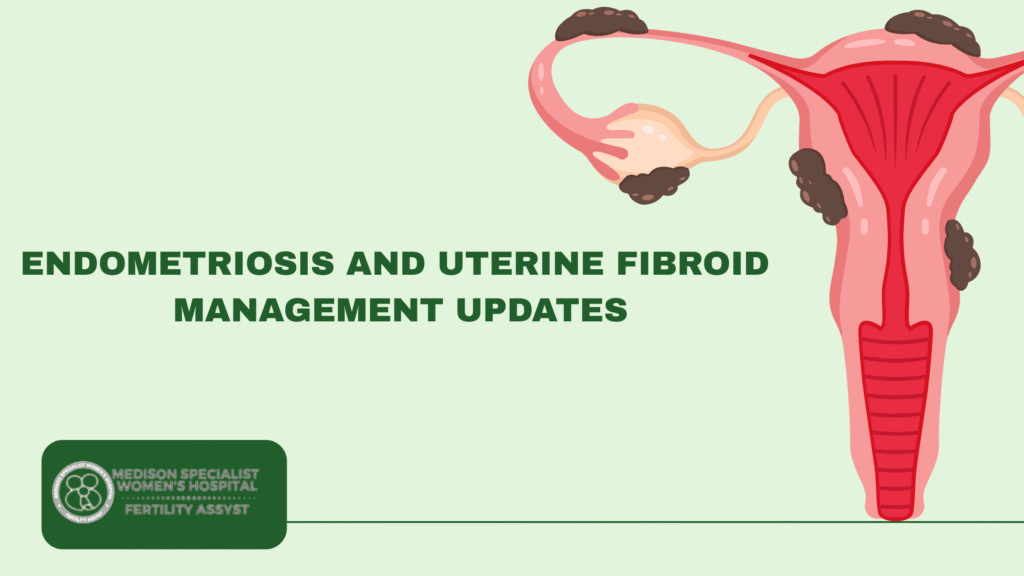- November 3, 2025
- By: The Medison Hospital
- No Comments
Latest Update on the Management of Endometriosis (2025)
Endometriosis and uterine fibroids affect millions of women worldwide, but advances in medicine are now making treatment more effective and less invasive than ever before.
While there’s currently no permanent cure, both conditions can be successfully managed with the right medical care and lifestyle support.
Stepwise Treatment for Endometriosis
1. Pain Relief
Management often begins with doctor-guided pain relief, using non-steroidal anti-inflammatory drugs (NSAIDs) or paracetamol for up to three menstrual cycles.
If symptoms persist, further options are explored.
2. Hormonal Therapy
Hormonal treatments help suppress endometrial lesions and reduce pain.
Doctors may recommend combined oral contraceptives or progestogens, including long-acting options such as the hormonal intrauterine system (IUS).
These help control hormone levels and reduce painful symptoms.
3. GnRH Therapy
New oral GnRH antagonists — such as elagolix, relugolix, and linzagolix — have been shown to effectively manage endometriosis pain and lesion growth with fewer side effects.
NICE (UK) now endorses long-term use of these medications with add-back therapy to maintain hormone balance.
4. Surgical Management
When medication isn’t enough, laparoscopic surgery remains the gold standard.
This minimally invasive approach removes visible lesions, releases adhesions, and can help restore fertility.
Modern techniques like AI-assisted laparoscopy and fluorescence-guided imaging are improving precision and recovery. In complex cases, robotic-assisted laparoscopy is increasingly being used — offering enhanced precision, 3D visualization, and faster recovery times.
The robotic system allows surgeons to operate with greater accuracy, especially in deep pelvic areas where endometriosis can be difficult to reach.
This approach minimizes complications and improves outcomes for patients desiring fertility preservation.
5. Emerging Therapies
Research is rapidly evolving — including stem-cell and exosome-based treatments, immune-modulating therapies, and microbiome-targeted approaches.
These aim to deliver personalized, regenerative care in the near future.
Modern Management of Uterine Fibroids
1. Medical Treatment
Treatment depends on symptoms and fertility goals.
First-line options include NSAIDs and tranexamic acid to reduce bleeding and discomfort.
Hormonal methods — like the hormonal IUS, combined pills, or progestogens — help regulate bleeding.
New oral GnRH antagonists also effectively shrink fibroids and control heavy menstrual flow.
2. Minimally Invasive Procedures
For women who want to preserve fertility, newer, less invasive treatments are available:
-
Uterine artery embolization (UAE) to block fibroid blood supply
-
MRI-guided focused ultrasound (MRgFUS) to shrink fibroids without surgery
-
Radiofrequency ablation to target fibroid tissue through small incisions
3. Surgical Options
-
Laparoscopic or robotic myomectomy removes fibroids while keeping the uterus intact.
-
Hysteroscopic resection treats submucosal fibroids (those inside the uterine cavity).
-
Hysterectomy — removal of the uterus — remains a last resort for severe or recurrent cases.
4. Research and Future Therapies
Ongoing trials are exploring collagenase injections, gene therapy, and vitamin D analogues for fibroid shrinkage.
Research continues to focus on tailored, fertility-sparing, and less invasive solutions.

